Signify, the company behind the Philips Hue line of lights, recently introduced new filament bulbs, which are designed to look like vintage filament-style light bulbs.
These bulbs, which come in three sizes, are the first bulbs in the Philips Hue lineup that are meant to be used with or without a lamp shade, making them perfect for decorative-style lamps that are meant to have naked bulbs.

There's a Standard A19 bulb that's in the shape of a traditional lightbulb, an Edison ST19 bulb that's elongated and without the rounder bulb shape, and there's the Globe G25 bulb, the largest of the three, which looks like a larger version of the Standard A19.

Though designed to look like vintage filament bulbs, the Hue Filaments are LED bulbs and not incandescent bulbs so they don't get hot at all when in use. You can touch the naked bulb and not feel a thing besides a bit of warmth.
The filaments inside the Hue Filament bulbs are arranged in an attractive spiral shape, with all of the bulbs in different sizes using the same internal design.
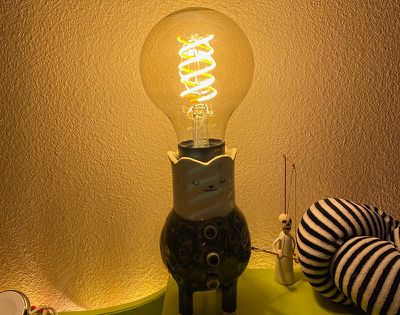
All three of the Filament bulbs from Hue are white light only, which means colors are not supported. The default color is a soft, warm yellow, which is ideal for accent lighting and dimmer indoor lighting. For those familiar with the white lighting spectrum, these are 2100K bulbs.
There's just the one yellow shade with no option to change the white light temperature, but the Filament bulbs can be dimmed or brightened to adjust the lighting that is put off. The bulbs can get surprisingly bright, which allows them to light up a room when you're using a few.
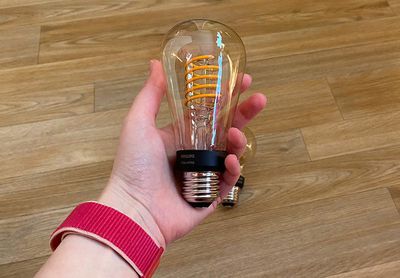
Each of the bulbs measures in at 530 lumens, so these are not as bright as your average 60-watt bulb. For comparison's sake, some of the standard Hue bulbs are upwards of 800 lumens, so don't expect the same maximum brightness levels (though you probably wouldn't want that much brightness from a bulb without a lamp shade).
In a naked lamp that's at eye level, a full brightness Filament bulb is impossible to look at, so I appreciated the ability to dim the bulbs down from their maximum brightness. I'm using one of the bulbs in a little monster lamp that I have and at low light, it works perfectly.
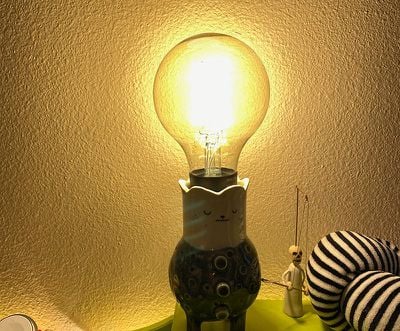
Since these are mostly designed to be used without a lamp shade, the Filament bulbs are probably best used at dimmer light, but in a ceiling lamp or up hung up above, the brighter lights will work well and will put off a decent amount of light.
These bulbs are part of the Philips Hue Bluetooth line, which means you can directly control them using the Philips Hue Bluetooth app even if you don't have a Hue Bridge. If you do have a full Hue setup with a bridge, these bulbs are also compatible, and the bridge, of course, adds HomeKit so you can control the Filament bulbs with Siri.
I didn't extensively test these on a standalone basis with the Bluetooth app because I do have an existing Hue setup, but I did try them out with the Bluetooth app and found the control to work well, though response times are bit slower compared to a bridge connection.
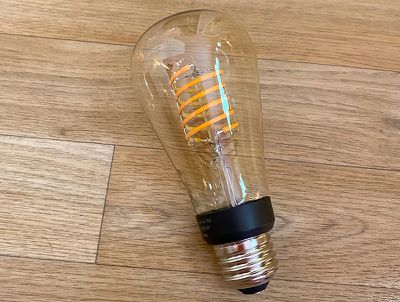
Offering the option to connect to the newest Hue bulbs with Bluetooth is a great move by Philips because now people can experience Hue bulbs and control their lights without committing to an entire setup.
As with all Hue bulbs that are able to connect to the Hue Bridge, the Filament bulbs can be used in HomeKit scenes and automations alongside other HomeKit products, and can be controlled either through the Hue app or Apple's own Home app.
Bottom Line
If you've been waiting for a Hue bulb that's able to work in a lamp without a lamp shade, the Filaments are the bulbs for you.
The vintage look is perfect for a naked lamp, and the soft white light works well without a lamp shade. The spiral design is attractive, HomeKit support is included, and if you don't have a Hue Bridge, you can still control these and use dimming and on/off functionality over Bluetooth.
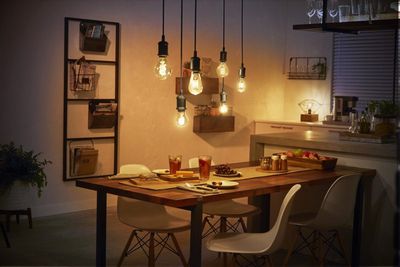
The bulbs are versatile, look fantastic, put off a good amount of light for a decorative bulb, and are an excellent addition to the Hue family. In the future, I'd love to see colored bulbs in this style or adjustable shades of white, but I'm not familiar with the technical details or what would be required for Signify to ultimately release such a product.
For now, though, these are a great option for those who need a more decorative bulb than the traditional Hue offerings.
How to Buy
The Hue Filament Smart Bulbs can be purchased from the Best Buy at the current time. The A19 model is priced at $24.99, the Edison ST19 is priced at $27.99, and the Globe G25 is priced at $32.99.























Top Rated Comments
I pay a little more so I get better products and the talented people who make them can earn a wage instead of waiting for a charity handout from you.
Stainless steel appliances have been in style for decades now, but surely this fad will go away any day now...
“With the Philips Hue bulb, the wattage display on the Kill A Watt unit steadily hovered between 0.0 watts and 0.3 watts—it uses up so little electricity that the Kill A Watt was barely registering anything at all, but it was still registering something.
But for the sake of data and doing some math, let’s average it out and say that the bulb pulls 0.15 watts of power when it’s on “standby.” To figure out how much that’s costing you on your electric bill, we first need to convert that wattage into kilowatt-hours (kWh).
Long story short, it would take roughly 6,600 hours before a Hue bulb uses up 1 kWh of power in standby mode (or 9.17 months). Depending on where you live, the cost for a single kWh of power differs, but for me it costs 15 cents. Therefore, a Hue bulb in standby mode costs around 1.6 cents per month—at least in my area.”
https://www.howtogeek.com/341872/do-smart-bulbs-use-up-electricity-even-when-they’re-off/
Once you’ve set them up to sunrise and sunset timers, as well as other timers, you never really have to touch a light switch. Which also means no more forgetting to turn a light off.
I run 21 Hue lights in my home varying from the play bars behind the tv to the basic bulbs outside. My electric bill went down once I started using them. So much so that I have 16 of those 21 lights on every single night 20 minutes before sunset until midnight when they shut off except for the 4 that I leave on outside and 3 I keep on inside until sunrise.
As for the bulb costs, some are super expensive (the play bars I bought 3 of were $200) but Ive been getting the basic white ones from $11 to $13. Far from expensive.
I do give to charity and absolutely think we should take more care of each other on this planet, but I could definitely sacrifice and give away a lot more without suffering too much… So, what is okay for me as a ”middle class” person to buy and how much can it cost? ?